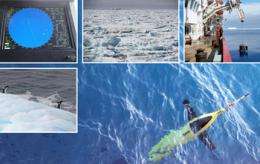Caltech oceanographer tests new technology at the bottom of the Earth

(PhysOrg.com) -- The field of study of Andrew Thompson, assistant professor of environmental science and engineering at Caltech, presents not only theoretical challenges but logistical ones as well. That's because he is interested in the circulation and ecology of the Southern Ocean—a cold, remote region near Antarctica—and the role it plays in global climate.
In particular, he studies a marine area at the eastern tip of the Antarctic Peninsula, part of the Weddell Sea. The hostile environment of the Weddell Sea makes long-term research difficult, so he's part of a team that is seeking to monitor the region with autonomous underwater vehicles called gliders. Last month, Thompson set off on a research cruise to deploy three of these new gliders, as well as some surface drifters that follow the currents and can be tracked with global positioning system (GPS) receivers.
"The currents and fronts in this region are important because they determine the transport and dispersal of krill—an important part of the ocean food chain—and also interact and modify the outflow of dense Antarctic Bottom Water, which eventually sinks to become the densest water in the ocean," says Thompson. "This part of the Weddell Sea is the injection point for krill and these dense water masses into the greater Southern Ocean."
The team, which included researchers from the Virginia Institute of Marine Sciences, the British Antarctic Survey, and from the University of East Anglia in the U.K., collected hydrographic data from the ship—such as the temperature, salinity, and density of the water—when they weren't busy with the gliders.
"We captured the signature of dense Antarctic Bottom Water at the shelf break cascading off the continental shelf," says Thompson, who says the group spent a lot of time keeping the gliders out of the way of iceberg C-19, formed in 2002 on the opposite side of Antarctica. "It originally had a surface area of 5500 square km, but is now about 800 square km. We have some great measurements right in the lee of the berg and see evidence of it significantly disrupting the currents in the region."
The team also successfully tested an echo sounder that they attached to the gliders to measure krill biomass. The echo sounder uses sonar to detect krill swarms in the water column.
"A major purpose of the cruise was to demonstrate the capability of ocean gliders to play a key role in future polar ocean observing systems," he says. And so far, the instruments have shown favorable results. The gliders were deployed on January 23; since then, they’ve been collecting samples and reporting data back to Thompson via satellite when they come to the surface every few hours. At press time, the Caltech glider had just completed its 200th dive. It, along with the other two gliders, will be recovered at the end of the experiment in mid-March.
In addition to research success, the crew, which returned to land in early February, had the chance to experience some marine wildlife in their natural habitat. The boat was visited by a number of friendly humpbacks and, while taking measurements from the sea, researchers found a pod of feeding orcas.
For more pictures and details from the trip, visit Thompson's website. The "journals" section gives personal accounts and images from the voyage.
Provided by Caltech



















